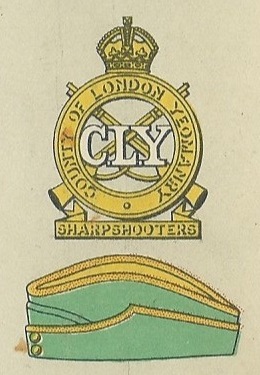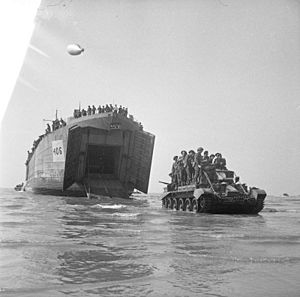3rd County of London Yeomanry (Sharpshooters) facts for kids
Quick facts for kids 3rd County of London Yeomanry (Sharpshooters) |
|
|---|---|

Badge and service cap as worn at the outbreak of the Second World War
|
|
| Active | 23 July 1901 – 1 May 1961 |
| Country | |
| Branch | |
| Type | Yeomanry (First World War) Royal Armoured Corps (Second World War) |
| Size | Three Regiments (First World War) Two Regiments (Second World War) |
| Garrison/HQ | Allitsen Road, St John's Wood |
| Engagements | First World War
|
| Commanders | |
| Notable commanders |
William Onslow, 6th Earl of Onslow |
The 3rd County of London Yeomanry (Sharpshooters) was a special cavalry unit in the British Army. It started in 1901 with soldiers who had fought in the Second Boer War.
During the First World War, the Sharpshooters fought on foot in Gallipoli. Later, they rode horses in Macedonia, Egypt, and Palestine. Eventually, they became machine gunners on the Western Front.
Between the World Wars, the unit changed to use armoured cars. It grew bigger and formed a new unit, the 4th County of London Yeomanry (Sharpshooters). Both units fought bravely in the North African Campaign, including the famous Second Battle of El Alamein. They also served in Sicily and Italy.
In 1944, because of many losses, the two units joined together. They became the 3rd/4th County of London Yeomanry (Sharpshooters). This combined unit fought through the rest of the war in Europe. After the war, in 1961, the Sharpshooters merged with another unit to form the Kent and Sharpshooters Yeomanry.
Contents
The Sharpshooters' Beginnings
The idea of volunteer soldiers helping in the Second Boer War came up in 1899. After some tough defeats, the British government needed more troops. So, they created the Imperial Yeomanry on December 24, 1899.
One special group was the 18th Battalion, formed in 1900. It was called "Sharpshooters." Unlike other units, these soldiers were chosen for their excellent shooting and horse riding skills. They were recruited from London and Scotland.
This idea worked well, and more Sharpshooter battalions were formed in 1901. On July 23, 1901, the 3rd County of London Imperial Yeomanry (Sharpshooters) was officially created. It was made up of veterans from these earlier Sharpshooter units.
- Regimental Headquarters (RHQ) was first in London, then moved to Regent's Park.
- Squadrons (groups of soldiers) were formed from veterans and new recruits.
- They also had a special Machine Gun Section.
Joining the Territorial Force
In 1908, the unit changed its name to the 3rd County of London Yeomanry (Sharpshooters). It became part of the Territorial Force. This force was a group of part-time soldiers trained like hussars (light cavalry).
In 1912, the regiment moved its base to Henry Street in St John's Wood. Before the First World War, it was part of the London Mounted Brigade.
The Sharpshooters in World War I
When First World War began in August 1914, many soldiers in the Territorial Force volunteered to serve overseas. Because of this, units were split into different "Lines."
- 1st Line units went to fight overseas.
- 2nd Line units stayed home for defense.
- 3rd Line units trained new soldiers to replace those fighting.
1st Line: Fighting Overseas
The 1st Line regiment gathered in Berkshire when the war started. In April 1915, they sailed to Egypt. They helped defend the Suez Canal.
In August 1915, the regiment had to fight on foot in the Gallipoli Campaign. They landed at Suvla Bay and fought in battles like Scimitar Hill. They suffered many losses. After Gallipoli, they returned to Egypt and got their horses back.
From late 1916 to mid-1917, the Sharpshooters fought in the Salonika Campaign. Then, they returned to Egypt and joined the Yeomanry Mounted Division. They took part in the Third Battle of Gaza, including the Battle of Beersheba. They also helped capture Jerusalem.
In April 1918, the unit changed again. The Sharpshooters and another unit, the City of London Yeomanry, joined to form E Battalion, Machine Gun Corps. This new machine gun unit was sent to France. In August 1918, it was renamed 103rd (City & 3rd Cty. of London Yeo.) Battalion, Machine Gun Corps. They fought on the Western Front until the war ended.
2nd Line: Home Defense
The 2nd Line regiment formed in London in August 1914. They were stationed in Norfolk. In 1916, they became a cyclist unit. They stayed in England, moving to different locations like North Walsham and Reepham.
In May 1918, the 2nd Line regiment moved to Ireland. They remained there until the end of the war, still serving as a cyclist unit.
3rd Line: Training New Soldiers
The 3rd Line regiment was created in 1915. Its job was to train new recruits and send them as replacements to the 1st and 2nd Line units. They were based at The Curragh in Ireland.
Between the World Wars
After the First World War, in 1920, the regiment was reformed. It was decided that most cavalry units would no longer use horses. So, the Sharpshooters became the 5th (London) Armoured Car Company, Tank Corps.
Later, in 1922, it was renumbered as the 23rd (London) Armoured Car Company, Royal Tank Corps. In 1939, it became part of the Royal Armoured Corps.
As another war seemed likely, the Territorial Army grew bigger. On August 24, 1939, the Sharpshooters became a full armoured regiment again, taking back its original name: 3rd County of London Yeomanry (Sharpshooters). Soon after, on September 29, it helped create a new, second unit: the 4th County of London Yeomanry (Sharpshooters).
The Sharpshooters in World War II
3rd County of London Yeomanry (Sharpshooters)
The 3rd and 4th CLY units had very similar experiences during the early part of World War II. Both were part of the 22nd Armoured Brigade. They stayed in the United Kingdom until October 1941, when they moved to North Africa.
Both regiments fought in major battles in North Africa. These included Operation Crusader (1941), the Battle of Gazala (1942), and the First Battle of El Alamein (1942). They were part of the 1st and 7th Armoured Divisions.
In September 1942, the 3rd CLY left its brigade for more training. They learned to use the new Sherman tank.
In July 1943, the 3rd CLY joined the 4th Armoured Brigade in Sicily. They took part in the invasion of Sicily. Then, they moved to Italy, fighting in battles like the advance across the Sangro river. In January 1944, the regiment returned to the United Kingdom to prepare for the invasion of Northern France.
The regiment landed in Normandy, France, on June 7, 1944, the day after D-Day. For the next two months, they fought in battles like Operation Epsom and the Battle for Caen.
Because of many losses, especially by the 4th CLY, the two Sharpshooters regiments joined together. On August 1, 1944, they formed the 3rd/4th County of London Yeomanry (Sharpshooters).
4th County of London Yeomanry (Sharpshooters)
The 4th CLY was formed in September 1939, created from the 3rd CLY. It also joined the 22nd Armoured Brigade. Its early battles were the same as the 3rd CLY, including Operation Crusader, the Battle of Gazala, and the First Battle of El Alamein.
The 4th CLY played a key role in the Second Battle of El Alamein in October-November 1942. They then advanced into Tunisia. They did not go to Sicily but landed in Italy in September 1943. They helped capture Naples and cross the Volturno river. In December 1943, they returned to the UK to prepare for the invasion of North West Europe.
The regiment landed in Normandy on June 7, 1944, the day after D-Day. During the Battle of Normandy, the 4th CLY was part of the 7th Armoured Division. On June 13, they faced a surprise attack near Villers-Bocage. A German Tiger tank commander, Michael Wittmann, attacked their lead group. The 4th CLY lost many tanks and its commanders in this battle.
Despite these heavy losses, the unit quickly regrouped. They continued fighting, including in Operation Goodwood.
Due to the many losses, especially at Villers-Bocage, the 4th CLY joined with the 3rd CLY on August 1, 1944. They formed the 3rd/4th County of London Yeomanry (Sharpshooters).
3rd/4th County of London Yeomanry (Sharpshooters)
This combined regiment was formed on August 1, 1944. It replaced the 3rd CLY in the 4th Armoured Brigade. This new unit fought through the rest of the Second World War.
They took part in important battles like the Battle of Mont Pincon, The Nederrijn, The Rhineland, and The Rhine. They ended the war in Germany.
After the War
In September 1946, the regiment was put on hold in Germany. It was reformed on January 1, 1947, as the 3rd/4th County of London Yeomanry (Sharpshooters) in the Territorial Army. Its headquarters and three squadrons were in London.
The Sharpshooters first served as an armoured regiment. In 1956, its role changed, and it became a reconnaissance (scouting) regiment.
In 1960, many Yeomanry Regiments were combined. On May 1, 1961, the Sharpshooters merged with the Kent Yeomanry. This new unit was called the Kent and County of London Yeomanry (Sharpshooters).
Unit Traditions and Honors
Uniforms and Appearance
When serving in South Africa, the Sharpshooters wore standard khaki uniforms. When they became a permanent unit in 1902, they were allowed to wear a special "bright dark green" uniform. This uniform was in the style of hussars, with gold braiding for officers and bright yellow cords for other ranks. They also wore fur hats called busbies with green and yellow feathers.
Over time, these uniforms became simpler and less colorful. After 1914, the regiment wore the standard British Army uniforms for fighting. However, they kept some traditional features, like the green and yellow cap, for special occasions.
Battle Honors
The 3rd, 4th, and 3rd/4th County of London Yeomanry (Sharpshooters) earned many special awards called battle honours. These honors recognize their bravery and success in battles.
- Second Boer War: South Africa 1900–02
- First World War: Pursuit to Mons, France and Flanders 1918, Macedonia 1916–17, Suvla, Scimitar Hill, Gallipoli 1915, Egypt 1915–16, Gaza, El Mughar, Nebi Samwil, Palestine 1917–18
- Second World War:
* Some honors were given to the combined 3rd/4th CLY. * Some were given specifically to the 3rd CLY (marked 3). * Some were given specifically to the 4th CLY (marked 4). * Villers Bocage4, Odon3, Defence of Rauray3, Caen4, Bourguébus Ridge4, Falaise, Lower Maas, Rhineland, Hochwald, Rhine, Aller, North-West Europe 1944–45 * Tobruk 19413,4, Bir el Gubi3,4, Gabr Saleh3,4, Sidi Rezegh 19413,4, Chor es Sufan3,4, Gazala3,4, Cauldron3,4, Hagiag er Raml3,4, Mersa Matruh3,4, Minqar Qaim3,4, Defence of Alamein Line4, Deir el Shein4, Ruweisat4, Point 933, Ruweisat Ridge3, Alam el Halfa3, El Alamein4, Akarit4, Djebel Roumana4, Tunis4, North Africa 1941–433,4 * Landing in Sicily4, Lentini4, Simeto Bridgehead4, Sicily 19434 * Termoli3, Sangro3, Fossacesia3, Volturno Crossing4, Italy 19433,4
Images for kids





